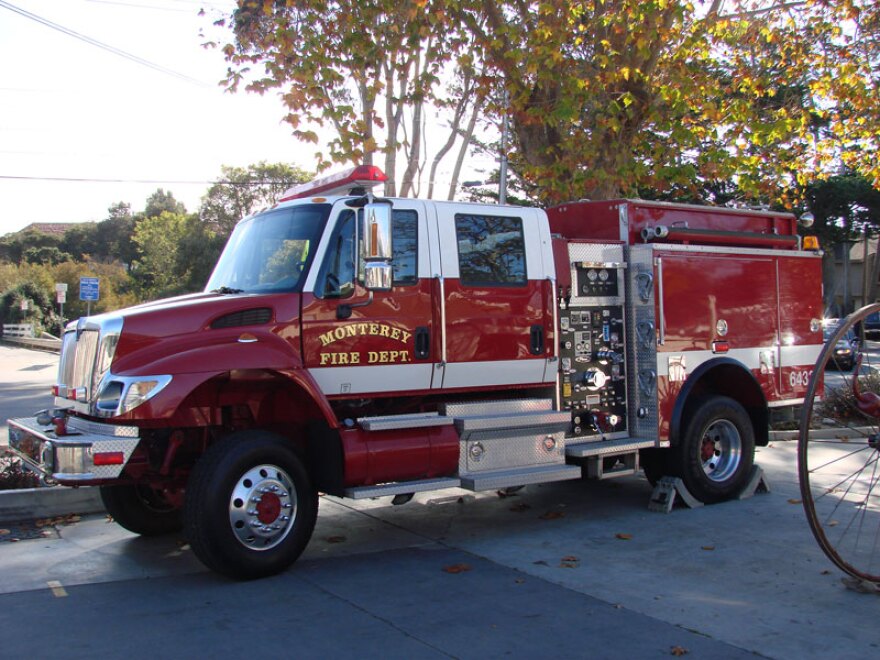Welcome to KAZU's weekly news roundup for 5/7/21. Here you'll find the top local stories of the week and a few national stories from NPR.
Monterey County could move into the Yellow Tier next Wednesday. A recent drop in the county’s case rate puts it on track to enter the less restrictive tier in the state’s Blueprint for a Safer Economy. But all of the metrics used to monitor the spread of COVID-19 in communities must remain stable or drop. A move into the Yellow Tier would mean restaurants and gyms can expand indoor operations to 50% and bars could open indoors at 25% capacity. We will find out whether the county moves next Tuesday. Santa Cruz County's COVID-19 case rate missed the mark for the Yellow Tier again this week, which means the soonest it could be eligible is May 19.
As of Monday the Grower Shipper Association of Central California (GSA) said 24,000 vaccinations have been administered to local agricultural workers at its clinics. GSA hopes by June, 35,000 ag workers will be fully vaccinated thanks to mass vaccination clinics organized in partnership with Clinica de Salud del Valle de Salinas. Harvest season is underway across the Central Coast and that means both local and migrant farmworkers are working in the fields. Estimates from last year suggest up to 60,000 ag workers will be working across the Central Coast by July — peak season.
COVID-19 Case Data at time of publishing:
- Santa Cruz County Cases - 16,062 total, 205 deaths
- Monterey County Cases - 43,563 total, 382 deaths
- San Benito County Cases - 6,045 total, 63 deaths
COVID-19 Vaccination Tracker:
- California - 43.2% of all residents fully vaccinated, 18.1% partially vaccinated (as of Thursday)
- Monterey County - 61% of residents (16+) received at least 1 dose (as of Monday)
- Santa Cruz County - 67.3% of residents (16+) received at least 1 dose (as of Monday)
Congestion at California’s ports is back in the headlines this week. KAZU’s newsletter in mid-April covered the recent traffic jam at the Oakland port — ships were getting too close to the protected Monterey Bay Marine Sanctuary. Now, the California State Board of Food and Agriculture is sharing their concerns over port congestion (California is the nation's largest agricultural exporter). In a webinar this week, solutions were discussed for a problem the board says isn’t a new issue but has grown worse during the pandemic.
The culprit in the Prunedale highway projectile attacks has been sentenced. KAZU covered the mysterious attacks and reported on the arrest of Charles Lafferty, 54, more than a year ago. Now, according to the Monterey County District Attorney’s office, Lafferty has pleaded guilty and will receive a stipulated sentence of 15 years in state prison. Forensic analysis linked Lafferty to more than 50 incidents of objects hitting moving cars. The DA's office said he admitted to shooting marbles at traffic with a slingshot but never said why.
The City of Monterey is considering three locations in its roadmap for commercial cannabis operations. The City Manager’s office is studying three areas because it believes that is the maximum number that can be profitable. The locations include Cannery Row, the Lighthouse District (in New Monterey) and the Old Town District (in downtown), but there is also interest from representatives in the North Fremont area. The “roadmap” is an effort to determine the viability and effects of retail cannabis sales in the city.
Twenty-two hospitality employers from across Monterey County will take part in a virtual job fair next week. That includes Pebble Beach Company, the Monterey Bay Aquarium and Cannery Row Management Co. Tourism businesses are currently on a hiring spree as pandemic restrictions decrease. The event takes place Thursday, May 13, from 10 a.m. to 1 p.m. Register here.

This week, NPR reported on California’s “deepening drought.” NPR’s Eric Westervelt visited Calistoga in Napa County to learn more about how the city is preparing. Read more about what climate scientists are saying about current conditions.
Are you ready for wildfire? The Monterey County Office of Emergency Services (MCOES) is urging residents to get ready in a variety of ways:
- Prepare defensible space around your home;
- Know if your home’s roof is high-risk for catching fire (different materials have different risks);
- Have a ‘Go Bag,’ which includes clothing for up to two weeks;
- Have a seven day supply of water, food and medicine if you are forced to shelter-in-place at home;
- Plan for power and communications outages;
- Know your exit routes and how to shelter-in-place safely;
- Sign up for emergency alerts and follow evacuation orders;
- Have a detailed list of your belongings for insurance purposes.
MCOES says this isn’t a list to choose a few things to do, it’s a list where every task should be taken care of. The agency says those who have all these strategies in place recover more quickly from wildfire. For more tips, visit the county’s Prepare Today page.
A group of scientists in Santa Cruz is experimenting with fungi to help heal toxic wildfire burn scars. As KAZU’s Michelle Loxton found out, mushrooms have an incredible ability to absorb toxins from the environment. CoRenewal, a local group that uses science to tackle environmental issues, is testing their ability to remove toxins from homes that burned down in last summer's wildfire.
A Santa Cruz photographer is showcasing the effects of the CZU Lightning Complex fires through art. The public is invited to the debut of the art installation at the Felton Branch Library and Discovery Park this Saturday from 10 a.m. to 2 p.m. — it’s an “Art Hike & Heal” event. The park’s nature loop is wheelchair accessible. Devi Pride, the photographer behind the project, is a fire survivor who dedicated the installation to “everyone who has personally felt the effects of the fires and to this beautiful land we call home.”


Local researchers are using Virtual Reality to illustrate the urgency of sea level rise. A new study, which will be published in the journal Water next Thursday, found the technology is working. Virtual Reality (VR) headsets immerse you into a 360-degree view of a virtual universe. Scientists say communicating the urgency of sea level rise is a difficult task because, to many, it feels like a far-off problem. But sometimes a picture is worth 1,000 words. Researchers from the Middlebury Institute of International Studies at Monterey and the City of Santa Cruz were instrumental in the research. Santa Cruz was the first adopter of the Sea Level Rise Explorer VR. Through the Resilient Coast Santa Cruz initiative, over 60 percent of VR participants at the Santa Cruz library reported a significant change in awareness of sea level rise, which researchers say helps with community engagement and planning for this coastal issue.
KAZU News has won two Regional Edward R. Murrow Awards. Every year, the Radio Television Digital News Association honors outstanding achievements in electronic journalism. The team won in the category of “Continuing Coverage” for our reporting during last summer’s historic wildfires in Monterey and Santa Cruz counties. KAZU was also honored in the category of “Breaking News Coverage” for Erika Mahoney’s reporting on the UC Santa Cruz graduate student strike for higher pay. You can stay up-to-date on our local stories by visiting our Local News webpage, downloading the KAZU mobile app or subscribing to our podcast.
Until next week,
The KAZU Team



